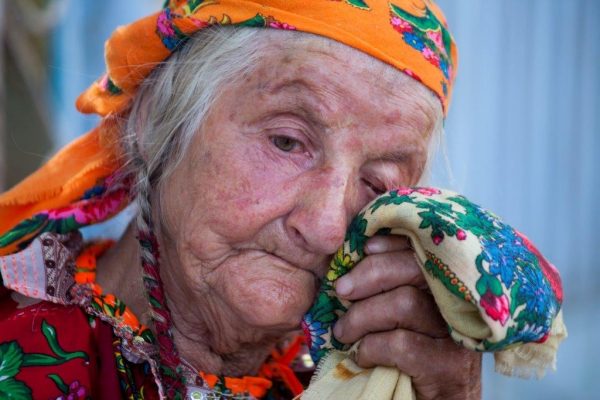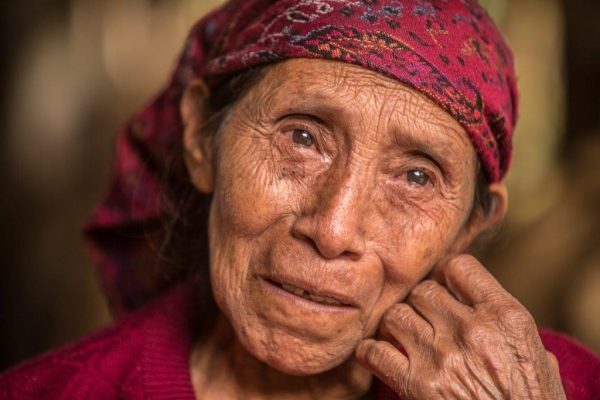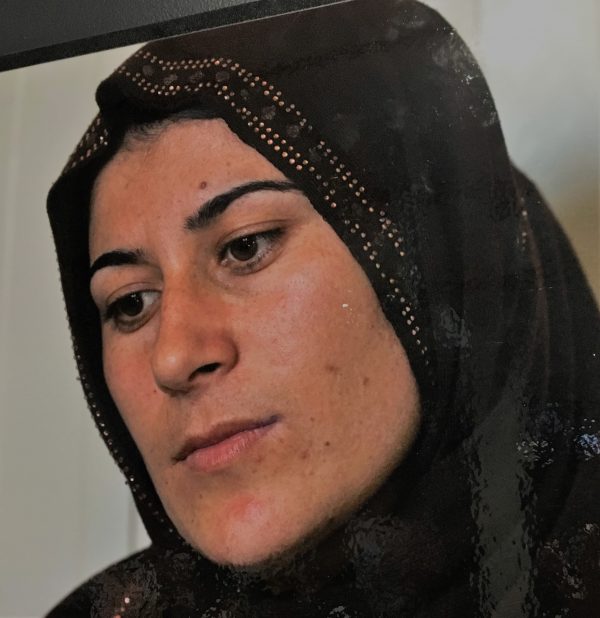“Women at the Frontline of Violence World Wide,” an exhibition at Los Angeles Museum of the Holocaust, documents the oral testimonies of nineteen women survivors of mass violence in four regions of the world: “Jewish female survivors of the Holocaust by Bullets in Eastern Europe; Roma female survivors of the Porajmos, the genocide against the Roma during World War II; indigenous women from Guatemala, victims of the internal armed conflict in the 1980s; and Yazidi female survivors, victims of ISIS in Iraq today.” The Museum and Yahad-In-Unum, in collaborating to present the stories of these survivors, hope to make the wartime atrocities women experience more commonly known. Their mission of education takes powerful form in the direct testimonies from women who have suffered the wounds of war.
The exhibition itself is stark, a room of portraits of women survivors. The impact of the exhibit comes about by using one of the four headphones to listen to the oral testimony behind each woman’s portrait. One enters the room with a superficial impression of the women’s faces, and leaves with a profoundly altered understanding of their war wounds, their stories of trauma, and the sexual violence they endured. Even from this small group of testimonials, 19 out of more than 6000 witness testimonies gathered by Yahad-In-Unum, patterns of the violence against women emerge from the past 70 years of war. Marco Gonzalez, Executive Director of Yahad In-Unam, has summarized the ways in which women have been frequently targeted: “From our investigations into the victims of genocide and mass violence, Yahad has seen that women have suffered in a distinct way: as victims of sexual violence, forced abortion, sterilization or sexual slaves,” “Violence against women during mass killings and genocide is an issue in its own right that needs to be further studied by scholars and better known by the public at large.”

In multiple conflicts, systematic rape continues to do untold damage to women of different ages, religion, economic caste and ethnicity. Rape is a common consequence of invasions, and in these regions it had a tactical purpose: to disrupt the reproductive capacity of an entire population. In these cases, rape is not an isolated or individual crime of passion. It is perpetrated deliberately by entire armies and groups of soldiers in order to interrupt, dismantle, and prevent a population’s reproductive future. Rape in this context is not only a war crime, it is an instrument that furthers the conquering army’s goal: genocide.

Jordanna Gessler, Educational director at Los Angeles Museum of the Holocaust, discussed these patterns of genocide, saying: “Human beings across the globe have a lot of commonality, both in what the victims experience, and what the perpetrators are doing. When people come to the museum and ask, why do we study the Holocaust seventy years later? Here is the answer: this is not going to stop until we come together and really have thoughtful conversations about how about how we can recognize human nature, and how we can support one another as human beings.”
As an example of the ongoing crimes that continue to be perpetrated against women in conflict zones, Gessler described the interconnected pattern of murder, violence and rape currently being reported from present day Iraq: “There have been many accounts in the last few years of ISIS militants take women as sex slaves. We have read reports of entire communities of men being murdered and women being taken and women being raped over and over and over again. Many of the interviews that Yahad did were in refugee camps. Women who are no longer able to be in their homes. Since August, 2014, thousands of Yazidi have been persecuted by ISIS. Men are shot. Women and young girls are sold and raped. And of course the young boys are forcibly converted to Islam and forced to become soldiers in ISIS, oftentimes brainwashed, often made dependent on drugs.”

Women in patriarchal cultures, including our own, are made to feel that they are responsible for the sexual crimes they suffer even when that act is the result of an external invasion. As a result, women victims of sexual violence have been silent, reluctant to expose themselves to the harsh consequences of having been attacked. They do not speak of what they have suffered. The crimes against them go unreported, unwitnessed, unpunished. And the crimes continue.
Beth Kean, the executive director of Los Angeles Museum of the Holocaust, is a granddaughter of two Holocaust survivors, Arnold and Rose Rakoszynski. and the exhibit is housed in a room at the museum that is dedicated to their memory. Kean’s family story speaks to the culture of silence so many victims of sexual violence observe, decades after the traumatic attacks they suffer.
“My grandmother was in a women’s camp called Ravensbruck…One of the things she never discussed was the forced prostitution and the rape. We didn’t learn about this until she was at her end of life, and things started coming out. She died in 2005, but when this museum opened, I was able to meet survivors who had also been imprisoned at Ravensbruck. When I told this survivor that my grandmother was liberated from Ravensbruck by Russians, she looked at me, and said, “I’m so sorry.”
I asked, “What are you talking about?”
She said, “I’m pretty sure your grandmother was raped. I don’t know any woman who was liberated by the Russians who was not raped.”
“It made sense to me. So this is an important personal story for me, and having this exhibit is important for me, because my grandmother felt ashamed. She was embarrassed to talk about it.
“This isn’t a topic that is easy for women to talk about. That is why this exhibit is important — because hearing their voices, gets the word out. We need to prevent this from happening again and again and again.”
About Los Angeles Museum of the Holocaust
Los Angeles Museum of the Holocaust, the first survivor-founded Holocaust museum in the United States, is a primary source institution that commemorates those who perished, honors those who survived, and houses the precious artifacts that miraculously weathered the Holocaust. Since 1961 the museum has provided free Holocaust education to students and visitors from across Los Angeles, the United States and the world, fulfilling the mission of the founding Holocaust survivors to commemorate, educate and inspire. The museum is open seven days a week, and admission is always free. lamoth.org
About Yahad-In Unum
Yahad-In Unum combines the Hebrew word Yahad, which means “together,” with the Latin phrase In Unum, which means “in one.” Founded in 2004 by Father Patrick Desbois, the organization is dedicated to documenting the evidence of the Holocaust in Eastern Europe and to work on the prevention of future genocides. Yahad-In Unum’s ongoing research on World War II crimes against Jews and Roma/Gypsy people in Eastern Europe has uncovered the location of more than 2,500 killing sites and documented more than 6,000 witness testimonies to these crimes. Yahad-In Unum is not affiliated with any political party and does not advocate any economic or military action. Its mission is to discover the facts of genocidal practices wherever they are and provide a voice of protest on behalf of all victims of genocide and mass violence. yahadinunum.org
Photo credits: Victoria Bahr/ Yahad-in Unam
